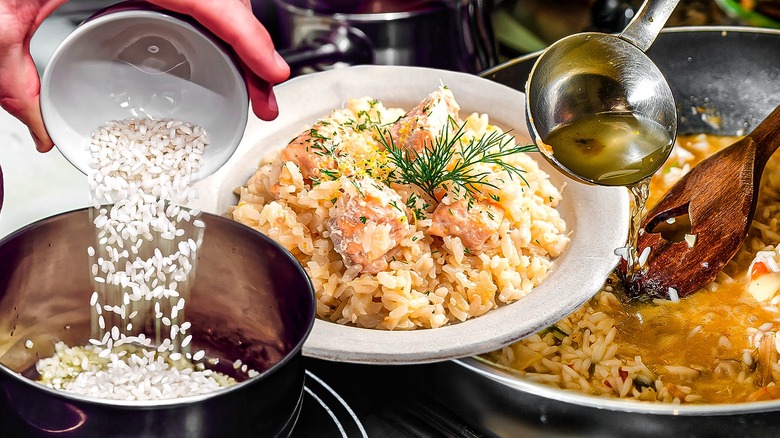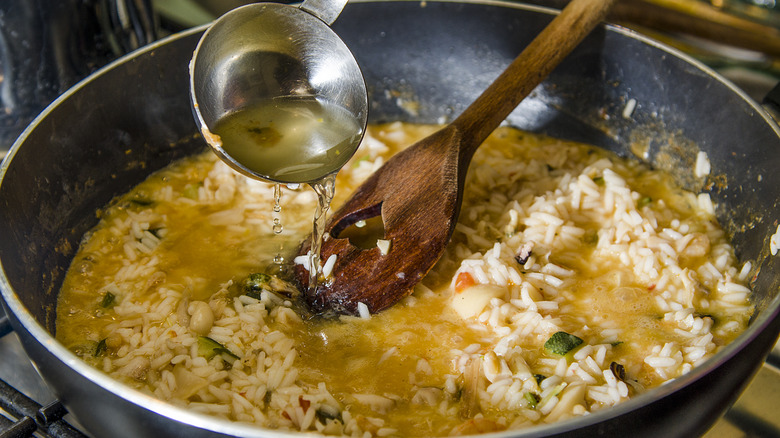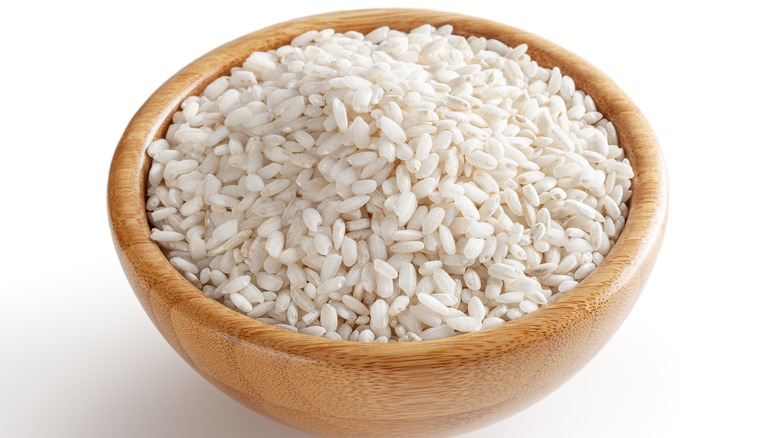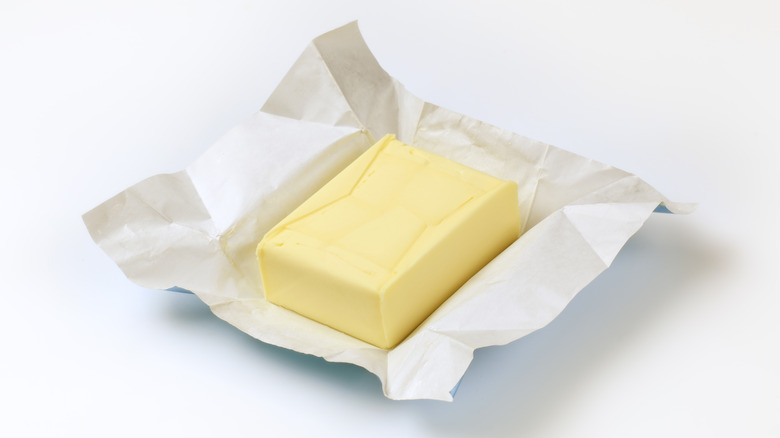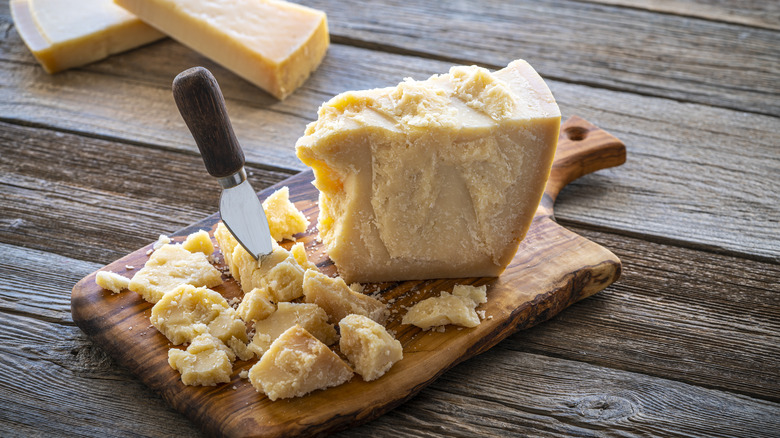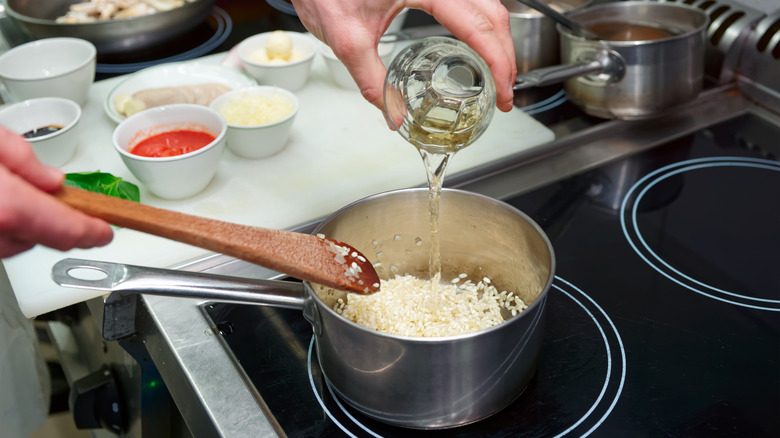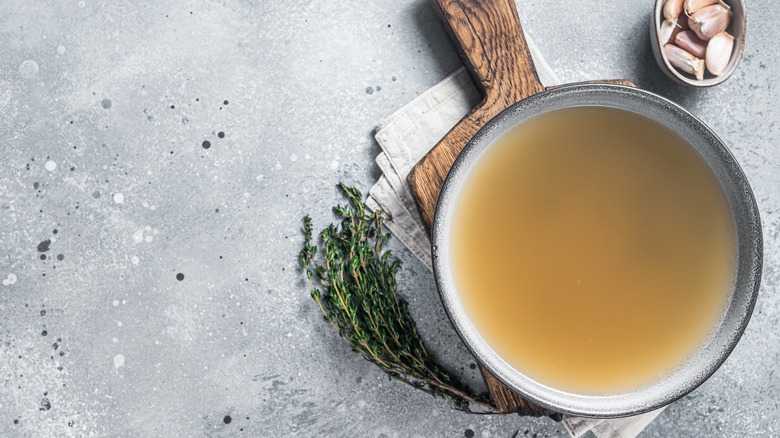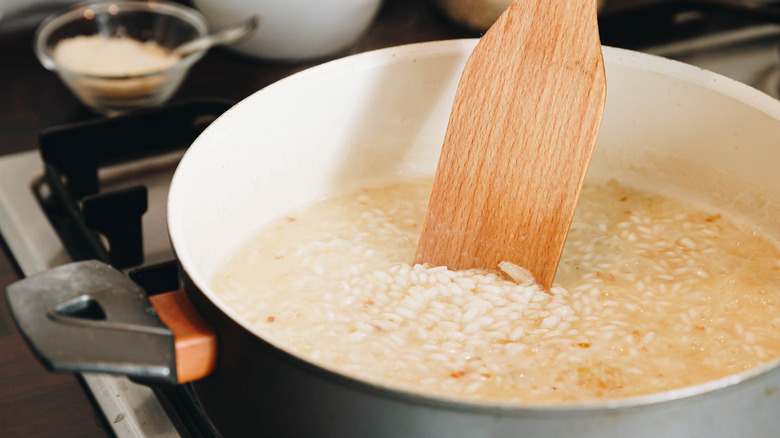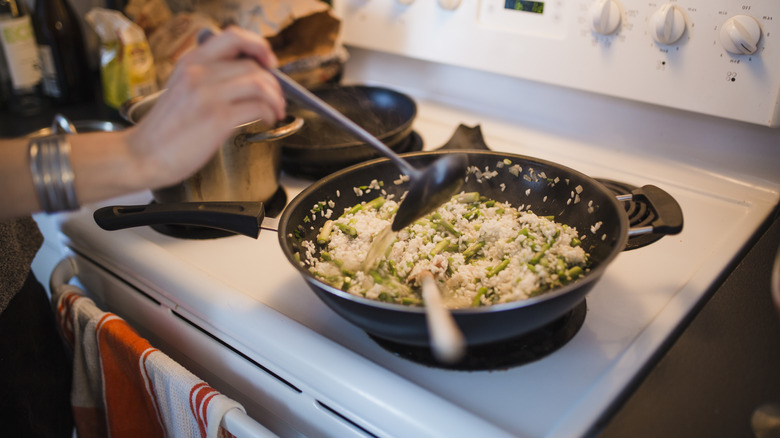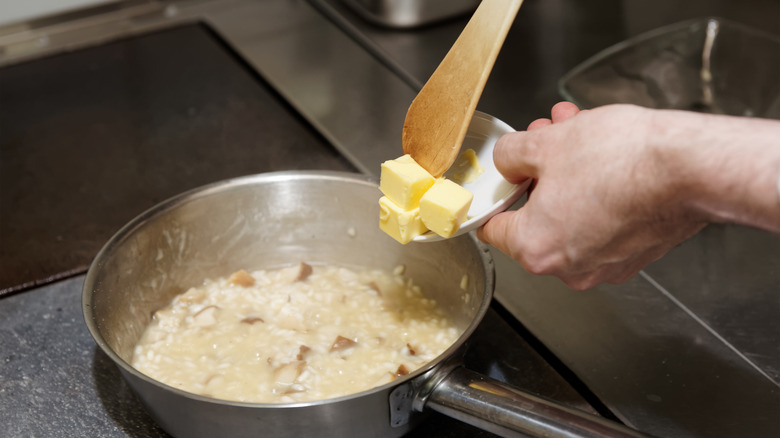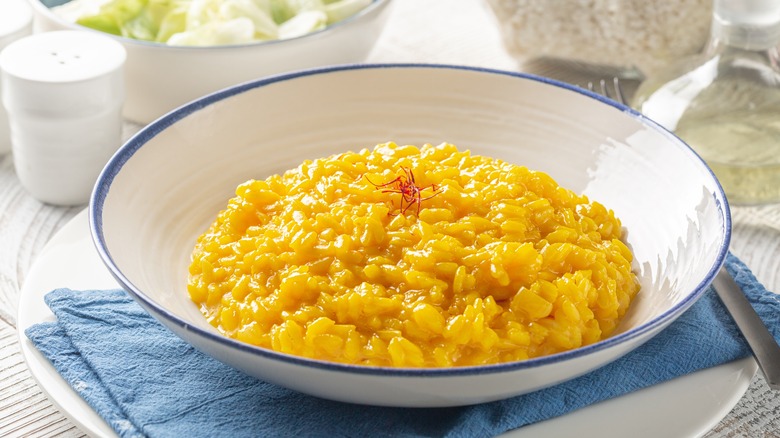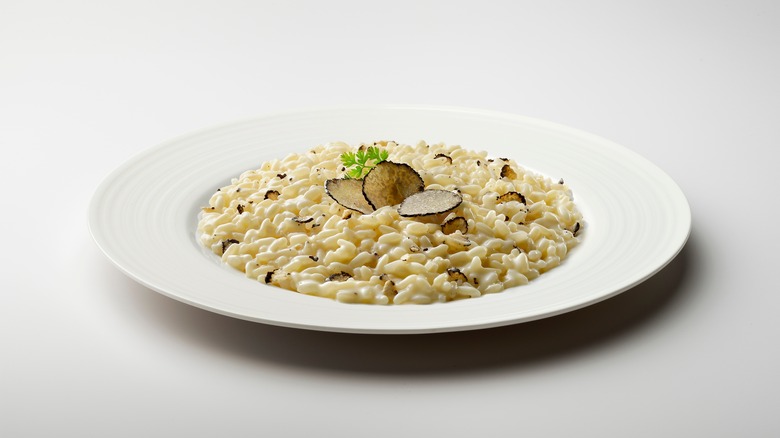13 Tips For Making Risotto Like A Pro
Few dishes are as comforting as a bowl of risotto. The quintessential Italian one-pot rice dish is beloved all over the world, and for many it's a regular on their weeknight rotation.
Risotto, like many Italian standards, is a dish that has a long, rich lineage. In Italy, rice has been cultivated for hundreds of years, and recipes resembling risotto have been around since the 16th century. Over time, risotto evolved. Nowadays, there are risottos for every occasion, taste, and dietary requirement.
Despite being such a versatile dish, risotto can be hard to perfect. Creating the perfect bowl of bowl rice is reliant on mastering a few key principles. To honor risotto's long history, and to make sure that your dish is just right every time, we've put together all of the tips that you need to make your risotto like a professional. Grab your spoon, and let's dig into some cooking knowledge.
1. Your cookware matters
To make risotto, the first thing you'll need is something to cook it in. While risotto can be baked, it's more traditionally cooked on the stovetop, in a pan that's allowed to gently simmer away as the stock is added bit by bit. But not just any pan will do, and if you pick the wrong one, you run the risk of your risotto becoming either too dry or too wet.
The best pan to go for is a medium-width, heavy-bottomed pan. The width of your pan plays a big part in determining the eventual consistency of your risotto. Pick a pan that's too wide and shallow, and your stock will evaporate too quickly, leaving you with a dry risotto. A pot that's too thin and tall, on the other hand, will retain the liquid and moisture too well, which may leave your risotto waterlogged. What you want is a pan that has a good middle ground, wide enough to let the liquid evaporate, but deep enough to allow you to stir your rice without worrying about it spilling over the sides.
A heavy-bottomed pan allows you not to worry about the pan moving around too much on the stove as you stir it. If you can find one, pans that have a curved bottom are also great for risotto, as you don't have to worry about rice getting lodged in the corners.
2. Start with the right rice
The type of rice you use for your risotto is crucial. Rice is an ingredient that varies considerably in starchiness and composition from type to type, and each will act differently in your risotto recipe.
You usually need short-grain rice with a high starch content to make the best risotto. The starch is essential, as that's what makes the sauce that coats each grain so creamy. For a foolproof choice, arborio rice is your best bet. Available in most grocery stores, this rice has loads of starch and is highly absorbent, meaning that your grains become fat and tender. If you want to really amp up the creaminess factor, try going for carnaroli rice instead. Carnaroli grains are slightly larger and starchier than arborio. This increased starchiness results in a sauce that's especially thick and luscious.
These are far from the only two types of rice you can use, though. Other rice varieties, like baldo and vialone nano, are also appropriate for risotto. It's best to avoid long-grain rice to make an authentic risotto, as these varieties aren't good at releasing starch.
3. Use enough fat
The combination of starchy rice and flavorful stock serves as the basis of a good risotto — but without fat, your dish will be nothing. Fat provides heft, texture, and taste to risotto. It's also a vital component for toasting your rice grains, which makes them stronger, helping them keep their shape when they simmer.
You need enough fat to coat each grain of rice sufficiently so that none of the grains burn during toasting. As for the type of fat you use, it's very much up to you. Most traditional chefs will opt for butter, as its creaminess works perfectly in the already-creamy dish, serving to make everything taste luxurious and comforting.
But if you want to double down on the richness, try using rendered pork fat from pancetta or bacon, or even duck fat. On the other hand, if you'd like a bit of a lighter touch to your risotto, olive oil is an excellent choice.
4. Don't skimp on the quality of your cheese
Risotto is nothing without cheese. While you technically can make risotto without it, a sprinkling of Parmigiano Reggiano at the end of your cooking process makes the meal into a bowl of sheer bliss. Adding cheese to a risotto also helps to bind the rice together more effectively while making the flavor more complex.
But you can't just use any old cheese. While cheaper cheeses might seem like a bargain, the fact is that they probably won't taste as good. Instead, view your cheese purchase as somewhat of an investment in flavor. Bear in mind, too, that there's a big difference between cheese Parmigiano Reggiano (which is, for many, the best type of cheese to be used in a risotto) and parmesan.
Parmigiano Reggiano has to go through a rigorous production process in Italy, which assures its quality and premium taste. Cheese labeled just as parmesan, on the other hand, doesn't need to be made with such exacting specifications, and so can vary wildly in flavor. For best results, look for Parmigiano Reggiano stamped with a "DOP" sticker, which indicates that it was made with traditional methods.
5. The wine you pick makes a big difference
Adding wine to risotto is crucial. A small glass of wine, poured into the rice mixture before you add the stock, imparts a depth of flavor into your dish that can't be achieved by other means, including an acidity that serves to cut through the density of it. Adding wine also deglazes the pan, loosening up all of those lovely crispy bits, and giving your rice extra flavor.
But you can't just throw in any wine for any risotto — you need to make sure it's well-suited to the flavors of your meal. For a simple mushroom risotto, try using a dry or semi-sweet Pinot Grigio. The wine has light, clean notes that undercut the earthy flavors of the mushrooms. Seafood or fish risotto benefits from a dry, full-bodied choice like an Arneis, but Pinot Grigio also works well. Slightly fruitier wines work best here, as they cut through the brininess of fish, and provide just a touch of sweetness.
The main rule of thumb when picking a wine, though, is to pick something that you would actually drink. After all, you're going to be putting it into your food, so you wouldn't want to use a bottle of something that you don't actually like very much. Plus, you can drink or serve the leftovers along with your meal.
6. Your stock should always be warm
You always need stock for risotto. Stock is the component that turns this dish from a semi-cooked pile of dry rice and still-crunchy vegetables into a succulent bowl of spoonable goodness. But if you've made your stock ahead of time — which can be a useful time-saver when it comes to cooking — you may have allowed it to cool. This is pretty much the worst thing you can do.
If you're not keeping your stock warm, things can go wrong fast. Your risotto mixture needs to be at a high enough temperature for everything to cook evenly, and if you're spooning ladles of cold stock into the hot rice, it will just cool everything down. This will lead to an unevenly-cooked risotto, as the temperature will constantly be fluctuating. Once you've made your stock, pour it into a pan next to your risotto, and keep it on low heat as you're cooking. It's a good idea to always make sure you're using high-quality stock, too — you're going to be putting a lot of it into your dish.
7. Keep your heat consistent
For such a tiny grain, rice can take a long time to cook properly. Your risotto rice needs to have sufficient time and heat for the stock to permeate and soften the grains. But if you're constantly fiddling with the temperature on your stove, things can be thrown a little out of whack and cook inconsistently, resulting in your risotto tasting a little off.
Keep your heat consistent. Ideally, you want a medium heat for your risotto, hot enough so that it stays gently simmering throughout the cooking process, without turning into a rolling boil. If you lower the heat too much, you simply won't be able to cook the rice properly, and it will stay underdone. Remember, too, that blasting your risotto with heat will not only cause the rice to become soft on the outside and hard on the inside, but it will also increase the risk of the rice burning on the bottom of the pan once the liquid evaporates, ruining your meal before you've even taken a bite.
8. Make sure you stir — but not too much
For some people, the thought of making risotto strikes fear into their hearts. Not because it's particularly difficult, but because they have images of having to stand over the stove, endlessly stirring, with no time to even check their phone.
The truth is, though, that it's not as laborious as you think. "Don't stress about constantly stirring risotto," says esteemed chef Antonio Salvatore, via Food & Wine. "It's much better to stir once every 30 seconds and trust the cooking process to do its thing." You'll want to avoid over-stirring risotto, as doing so will work the rice too much, breaking down the starches excessively and turning it into mush. You only want to stir it enough to keep the rice moving so that it doesn't end up sticking to the bottom of the pan. Remember that your simmering liquid will do a lot of the work for you.
9. Add your stock a little at a time
If you're a patient person, then risotto is the perfect meal. But if you're the kind of person that likes immediate results, it's a different story. While risotto doesn't take hours, it does require you to be actively cooking for a fair amount of time, and a large proportion of this is spent adding stock to cook the rice.
We can understand why you might just want to dump all your stock in and let it cook — but seriously, don't. Celebrity chef Lidia Bastianich explains why. "If you insert one thing in a solution, the dominant solution will prevail. If you insert a lot of water here, that's when the rice will open up because there's so much liquid," Bastianich says via Epicurious. Simply put, if you add all the stock at once, your rice will get way too soft, too quickly, and your risotto will resemble porridge.
Instead of making this grave mistake, add your stock a little at a time. Generally, a ladle every few minutes is sufficient. You want to add just enough to give the rice liquid to work with and cook it until it's all but gone, before pouring in the next load.
10. Be precise with your timings
Risotto rice, like other types of rice, can go wrong fast. There's an incredibly fine line between just-cooked risotto grains, which still have a tiny bit of bite to them while remaining soft, and over-cooked grains, which turn into a whole lotta nothing. It all comes down to timing. "One of the surest ways to ruin risotto is overcooking," chef Antonio Salvatore told Food & Wine. He's right: Cooking it for just a little too long will make the rice grains disintegrate, turning them into slop.
Set your timer once you start adding your stock. At medium heat, your rice should take a maximum of 20 minutes to be fully cooked. You can help yourself out by making the right ratio of stock to rice, with 2.5 cups of liquid for every dry cup of rice you're using. Remember to taste-test your risotto a few minutes before the 20-minute mark to make sure it's not cooked too quickly and to adjust any seasonings that you need to. Importantly, keep in mind that risotto will continue cooking gradually when you take it off the heat, especially if you're using a pan that retains heat well.
11. Remember your mantecatura
The secret to a next-level risotto is not the rice you use, the type of stock, or the quality of your butter (okay, it's all of those things, but we're making a point here, so just bear with us). No, for many, a risotto only truly shines at the end, in a process called "mantecatura."
Mantecatura is, essentially, when your risotto becomes very delicious, very quickly. It involves the addition of ingredients towards the end of your cooking process that make the rice mixture even creamier. For risotto, take some cold cubes of butter and your grated Parmigiano Reggiano, and place them near your pan. Then, take your pan off the heat. Tip your butter and cheese into the pan, and gently wiggle the ingredients in, stirring lightly if you need to make sure everything's incorporated. This final addition of ingredients will give your risotto a velvety lusciousness that will amp it up hugely. The coldness of the butter is vital, as this will allow it to release buttermilk when it comes into contact with the hot rice, adding to its texture.
12. Once it's ready, serve it immediately
No one likes to wait around for dinner, and in our humble opinion, you should always be serving food as quickly as possible. But this is never as important as with risotto. Serving risotto immediately is vital as allowing it to sit around even slightly too long will overcook it.
"Once it's cooked, you've got to get it going because it will continue to absorb liquid. You can't leave it," explains celebrity chef Lidia Bastianich, per Epicurious, who goes on to share a tale from her childhood. "I remember we used to get called to the table and the saying was that if you don't come in time, the risotto will wait for you at the door. Meaning that it grows."
Essentially, leaving your risotto will allow it to become even more voluminous, and not in a good way. It's also useful to eat risotto immediately as leaving it for too long will cause you to have to reheat it — and while this dish is good for many things, reheating is not one of them. Reheating risotto serves to cook the rice grains even further, and will just make the dish turn into a gruel-like consistency.
13. To dish it up like a pro, give it a spank
On the surface of things, serving risotto should be simple. You just pile it onto a plate, hand it to someone with a spoon, and allow them to enjoy the party, right?
Well, as it turns out, there's a secret technique to preparing risotto, which comes courtesy of none other than superstar chef Giada De Laurentiis. And it involves a little spanking. Wait, we can explain! When you plate up risotto, it has a tendency to turn into a rather unsightly clump on the plate. But Laurentiis, in a video on TikTok, shows that if you take the plate the risotto is on, and spank it from the bottom, the risotto will even out and spread across the serving dish.
You'll then be left with an evenly-sized portion of risotto, which has spread elegantly across the plate, adding a touch of class to the whole affair. You can then finish off your risotto with a sprinkling of herbs, a touch of Parmigiano Reggiano shaved on top, and if you're feeling fancy, a sprig of saffron. Thanks, Giada!
